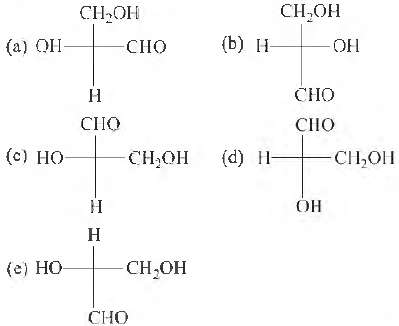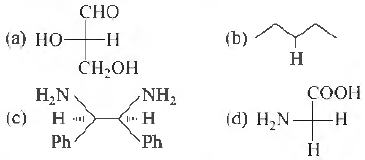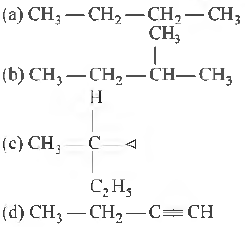Refer to CBSE Class 11 Chemistry Organic Chemistry Some Basic Principles and Techniques MCQs Set C provided below available for download in Pdf. The MCQ Questions for Class 11 Chemistry with answers are aligned as per the latest syllabus and exam pattern suggested by CBSE, NCERT and KVS. Chapter 8 Organic Chemistry Some Basic Principles and Techniques Class 11 MCQ are an important part of exams for Class 11 Chemistry and if practiced properly can help you to improve your understanding and get higher marks. Refer to more Chapter-wise MCQs for CBSE Class 11 Chemistry and also download more latest study material for all subjects
MCQ for Class 11 Chemistry Chapter 8 Organic Chemistry Some Basic Principles and Techniques
Class 11 Chemistry students should refer to the following multiple-choice questions with answers for Chapter 8 Organic Chemistry Some Basic Principles and Techniques in Class 11.
Chapter 8 Organic Chemistry Some Basic Principles and Techniques MCQ Questions Class 11 Chemistry with Answers
Question: Methoxyethane and propanol are the examples of isomerism of the type
a) structural
b) position
c) functional
d) tautomerism
Answer: c
Question: Which of the following Fischer's projection fommla is identical to D-glyceraldehyde?

Answer: b
Question: Metamers of ethyl propionate are
a) C4H9COOH and HCOOC4H9
b) C4H9COOH and CH3COOC3H7
c) CH3COOCH3 and CH3COOC3H7
d) CH3COOC3H7 and C3H7COOCH3
Answer: d
Question: n-pentane, iso-pentane and neo-pentane are examples for isomers of the type
a) geometrical
b) optical
c) chain
d) positional
Answer: c
Question: Different structures generated due to rotation about, C—C axis, of an organic molecule, are examples of
a) geometrical isomerism
b) conformational isomerism
c) optical isomerism
d) structural isomerism
Answer: b
Question: For which of the following parameters the structural isomers C2H5OH and CH3OCH3 would be expected to have the same values? (Assume ideal behaviour)
a) Heat of vaporisation
b) Vapour pressure at the same temperature
c) Boiling points
d) Gaseous densities at the same temperature and pressure
Answer: d
Question: Maximun1 enol content is in

Answer: b
Question: Which organic structure among the following is not an isomer of the compound CH3–CO–CH2CH2CH2CH3 ?
a) CH3CH2OCH =CHCH2CH3
b) CH3CH = CHCH2CH2CHO
c) (CH3)2CH–CO–CH2CH3
d) CH3CH2COCH2CH2CH3
Answer: b
Question: Select the molecule which has only one π-bond
a) CH ≡ CH
b) CH2 = CHCHO
c) CH3CH = CH2
d) CH3CH=CHCOOH
Answer: c
Question: Increasing order of stability among the three main conformations, (i.e. Eclipse, Anti, Gauche) of 2-fluoroethanol is
a) Eclipse, Gauche, Anti
b) Gauche, Eclipse, Anti
c) Eclipse, Anti, Gauche
d) Anti, Gauche, Eclipse
Answer: c
Question: The compounds CH3CH == CHCH3 and CH3CH2CH == CH2
a) are tautomers
b) are position isomers
c) contain same number of sp3– sp3, sp3– sp2 and sp2– sp2 carbon-carbon bonds
d) exist together in dynamic equilibrium
Answer: b
Question: Heterolytic fission of C – Br bond results in the formation of
a) free radical
b) carbanion
c) carbocation
d) Both carbanion and carbocation
Answer: c
Question: Geometrical isomerism is possible in case of
a) pentene-2
b) propane
c) pentane
d) ethene
Answer: a
Question: In this reaction,
CH3CHO+HCN → CH3CH(OH)CN
→H·OH CH3CH(OH)COOH
an asymmetric centre is generated. The acid obtained would be
a) 50% D + 50% L-isomer
b) 20% D + 80% L-isomer
c) D-isomer
d) L-isomer
Answer: a
Question: The number of isomers of the compound with molecular fommla C2H2Br2 is
a) 4
b) 3
c) 5
d) 2
Answer: d
Question: C6H5C = N and C6H5N = C exhibit which type of isomerism?
a) Position
b) Functional
c) Metamerism
d) Dextro-isomerism
Answer: b
Question: How many isomers are possible for the alkane C4H10 ?
a) 3
b) 5
c) 2
d) 4
Answer: c
Question: The number of primary, secondary, tertiary and quaternary carbons in neopentane are respectively
a) 4, 3, 2 and 1
b) 5, 0, 0 and 1
c) 4, 0, 0 and 1
d) 4, 0, 1 and 1
Answer: c
Question: Which of the following compounds contains 1°, 2°, 3° as well as 4° carbon atoms ?
a) Neopentane
b) 2-methyl pentane
c) 2,3-dimethyl butane
d) 2,2,3-trimethyl pentane
Answer: d
Question: The number of secondary hydrogens in 2, 2-dimethylbutane is
a) 8
b) 6
c) 4
d) 2
Answer: d
Question: The organic reaction which proceed through heterolytic bond cleavage are called ________
a) ionic
b) polar
c) nonpolar
d) Both ionic and polar
Answer: d
Question: Which of the following statements is false for isopentane ?
a) It has three CH3 groups
b) It has one CH2 group
c) It has one CH group
d) It has a carbon which is not bonded to hydrogen
Answer: d
Question: The IUPAC name of neopentane is
a) 2, 2-dimethylpropane
b) 2-methylpropane
c) 2, 2-dimethylbutane
d) 2-methylbutane
Answer: a
Question: The IUPAC name of the compound CH3 — CH(CH3) — CO – CH3, is
a) 3-methyl 2-butanone
b) 2-methyl 3-butanone
c) isopropyl methyl ketone
d) methyl isopropyl ketone
Answer: a
Question: Total number of structural isomers possible for C3H6 are :
a) 2
b) 1
c) 4
d) 3
Answer: a
Question: Which of the following molecules is expected to rotate the plane of plane polarised light?

First organic compound to be synthesised was
a) methane
b) cane sugar
c) acetic acid
d) urea
Answer: a
Question: Which of the following statements is false for isopentane–
a) It has three CH3 groups
b) It has one CH2 group
c) It has one CH group
d) It has a carbon which is not bonded to hydrogen
Answer: d
Question: The IUPAC name of the compound CH3OCH2CH2CH2OCH2CH3 is
a) 3-ethoxy-1-methoxypropane
b) 1-ethoxy-3-methoxypropane
c) 2, 5-dioxyhexane
d) ethoxypropane oxymethane
Answer: a
Question: Which of the following compounds is optically active ?
a) (CH3 )2CHCH2OH
b) CH3CH2OH
c) CCI2F2
d) CH3CHOHC2H5
Answer: d
Question: C6H5C ≡ N and C6H5N ≡ C are which type of isomers?
a) Position
b) Functional
c) Tautomerism
d) Linkage
Answer: b
Question: A functional isomer of 1-butyne is
a) 2-butyne
b) 1-butene
c) 2-butene
d) 1, 3-butadiene
Answer: d
Question: In which of the following, functional group isomerism is not possible?
a) Alcohols
b) Aldehydes
c) Alkyl halides
d) Cyanides
Answer: c
Question: Which one of the following shows functional isomerism?
a) C2H4
b) C3H6
c) C2H5OH
d) CH2Cl2
Answer: c
Question: The least number of carbon atoms in alkane showing isomerism is
a) 3
b) 1
c) 2
d) 4
Answer: d
Question: The number of possible alkynes with molecular formula C5H8 is
a) 2
b) 3
c) 4
d) 5
Answer: b
Question: The functional group present in organic, acid is –
a) – OH
b) – CHO
c) –COOH
d) > C = O
Answer: c
Question: Amongst the following compounds, the optically active alkane having lowest molecular mass is

Answer: c
Question: How many asymmetric carbon atoms are present in
I. 1,2-dimethylcyclohexane
II. 3-methylcyclopentane and
III. 3-methylcyclohexene ?
a) Two, one, one
b) One, one, one
c) Two, none, two
d) Two, none, one
Answer: d
| CBSE Class 11 Chemistry Structure of Atom MCQs Set A |
| CBSE Class 11 Chemistry Structure of Atom MCQs Set B |
| CBSE Class 11 Chemistry Structure of Atom MCQs Set C |
| CBSE Class 11 Chemistry Classification of Elements and Periodicity in Properties MCQs Set A |
| CBSE Class 11 Chemistry Classification of Elements and Periodicity in Properties MCQs Set B |
| CBSE Class 11 Chemistry Periodic Classification of Elements MCQs |
| CBSE Class 11 Chemistry Redox Reactions MCQs Set A |
| CBSE Class 11 Chemistry Redox Reactions MCQs Set B |
| CBSE Class 11 Physics Kinetic Theory MCQs Set C |
MCQs for Chapter 8 Organic Chemistry Some Basic Principles and Techniques Chemistry Class 11
Expert teachers of studiestoday have referred to NCERT book for Class 11 Chemistry to develop the Chemistry Class 11 MCQs. If you download MCQs with answers for the above chapter you will get higher and better marks in Class 11 test and exams in the current year as you will be able to have stronger understanding of all concepts. Daily Multiple Choice Questions practice of Chemistry will help students to have stronger understanding of all concepts and also make them expert on all critical topics. After solving the questions given in the MCQs which have been developed as per latest books also refer to the NCERT solutions for Class 11 Chemistry. We have also provided lot of MCQ questions for Class 11 Chemistry so that you can solve questions relating to all topics given in each chapter. After solving these you should also refer to Class 11 Chemistry MCQ Test for the same chapter.
You can download the CBSE MCQs for Class 11 Chemistry Chapter 8 Organic Chemistry Some Basic Principles and Techniques for latest session from StudiesToday.com
Yes, the MCQs issued by CBSE for Class 11 Chemistry Chapter 8 Organic Chemistry Some Basic Principles and Techniques have been made available here for latest academic session
You can find CBSE Class 11 Chemistry Chapter 8 Organic Chemistry Some Basic Principles and Techniques MCQs on educational websites like studiestoday.com, online tutoring platforms, and in sample question papers provided on this website.
To prepare for Chapter 8 Organic Chemistry Some Basic Principles and Techniques MCQs, refer to the concepts links provided by our teachers and download sample papers for free.
Yes, there are many online resources that we have provided on studiestoday.com available such as practice worksheets, question papers, and online tests for learning MCQs for Class 11 Chemistry Chapter 8 Organic Chemistry Some Basic Principles and Techniques

